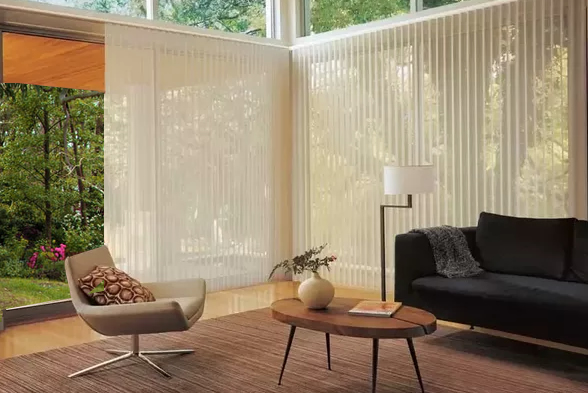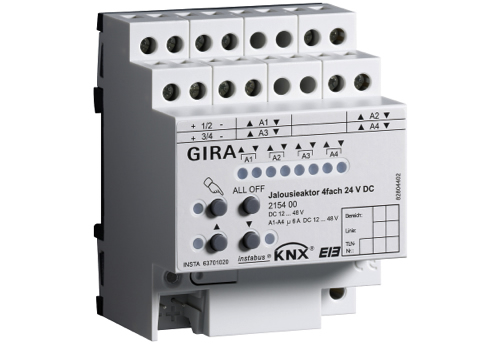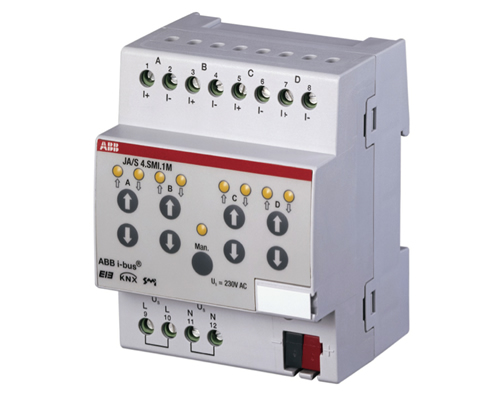 By Mark Warburton, Ivory Egg.
By Mark Warburton, Ivory Egg.
The change of seasons is a timely reminder of how much the external environment impacts on the internal spaces we live and work. It could be returning home to a dark house because the days are shorter, the sudden return of glare on your computer screen or the joy of being able to open doors because it’s ‘just’ warm enough outside. Regardless of the time of year, the barrier between inside and outside has a big effect on how we live and spend our time.
Glass is the usual delineator between these two environments, but efficient as modern glass is, on its own, it is not a sufficient barrier, nor does it provide the opportunity to adapt to the changes throughout the day and year. Even if you are working with switchable glass, in most cases an extra layer is required even if it’s just for comfort.

Consider window treatments from the outset
So, we are left to install some type of shading, be it curtains or blinds. Unfortunately, in a lot of installations, this crucial aspect of the system is considered part of the interior fit out, not the environmental control. This is unfortunate, because if the window treatments are specified from day one, and the type of fitting is known, the comfort and efficiency of the building can be dramatically increased.
This could be with simple timers that automatically close the blinds and curtains at night, ensuring any heat gained from the sun is kept in the building. Or it could involve a more intelligent control scenario utilising brightness, sun position and temperature to manage the brightness levels and room temperature throughout the day. Understanding the different ways to control curtains and blinds will ensure the entire system matches the required level of performance.
230V AC motors
The most common type, 230V motors, have a phase (live) for each direction of travel along with a common (neutral). Only one of the directions should be powered at any time which can be achieved with a software interlock on two standard relays or by using a dedicated blind controller which will have a relay that provides the interlock.
Most curtains and blinds will have an integrated limit switch which stops movement when it reaches the limit of travel. This can be relied on to stop movement, however the feed should be isolated a short time after. This is achieved by defining the run time of the fitting in the parameters of the actuator. Alternatively, blind control actuators are available which use current detection to determine when the fitting has reached its limit. This is a good option if the fitting is likely to be changed by the customer or if slightly more accurate positional control is required.
230V motors are the simplest and often the cheapest, so they are the most common. They are also able to have a high torque output and so will be required on larger fittings or where the fabric is heavy.
24V DC motors
DC motors can be smaller and quieter than the equivalent AC motor so they are particularly common in high-end residential applications. To control DC motors, the polarity of the DC feed to the motor is reversed. Most 24V DC KNX blind actuators will do this automatically but require a separate power supply to provide the 24V DC feed.

Another option is the Somfy Moco controller which has an integrated DC power supply, thereby reducing the number of products in the system and the complexity.
Wiring for DC motors is simple, as the only connection required to each blind is a two-core cable. As with 230V actuators, it is possible to define the run time or use actuators with current detection.
Contact closure
Certain manufacturers have a controller embedded into their motor or fitting. In this case, control is via contact closure which triggers the on-board controller to start the motor in the appropriate direction. Most of these blinds require a short pulse on an open or close input and a pulse on both to stop.
Because KNX blind controllers are designed to directly control the motor, it is advisable to use standard relays with blinds or curtains that have their own on-board controller. This makes it possible to close both outputs simultaneously for the stop command as this isn’t possible on a true KNX blind actuator.
Digital control
Like contact closures, some blind motors have an embedded controller that can receive the move and positional commands via a digital interface.
This could be a standardised solution such as an SMI (Standard Motor Interface) or a propriety solution such as Somfy’s Digital Network.

With this method, it is possible to control the blinds more accurately as the on-board controller can determine the positioning instead of guessing with the run time. Environmental conditions and individual motor performance can affect the run time of fittings, but as a digital control will overcome this, it is the only solution if accurate positioning or hem alignment is required.
It is also a more cost-effective solution when multiple fittings have to be controlled simultaneously, since multiple fittings can be controlled on the same output.
Fabric and type of fitting
There are countless styles of blinds and curtain, each with their own benefits, so putting yourself in a position to specify a shading solution can be daunting. The best approach is to find a supplier who can offer a wide range of fittings and fabrics but who also understands the different control aspects. There is nothing more frustrating than getting to site to find all the fittings have the wrong type of motor or that they don’t have a motor at all. A good example of a supplier is Oceanair, a UK-based manufacturer to the high-end residential and superyacht markets, which has recently installed a KNX test system allowing it to better understand the relationship between the controls, motors and fittings.
Conclusion
Intelligent shading control is usually considered to be a luxury on a building project as it can be difficult to see how the up-front cost of the solution will offer long-term benefits. By communicating clearly to the client and design team that the correct use of shading will save energy, make the building more comfortable and make creating the right internal environment easier, the shading will be viewed as a key component of the building instead of being part of the interior fit out.
Mark Warburton is the Technical Director of Ivory Egg (UK) Ltd, a supplier of leading KNX products and provider of KNX training courses.











